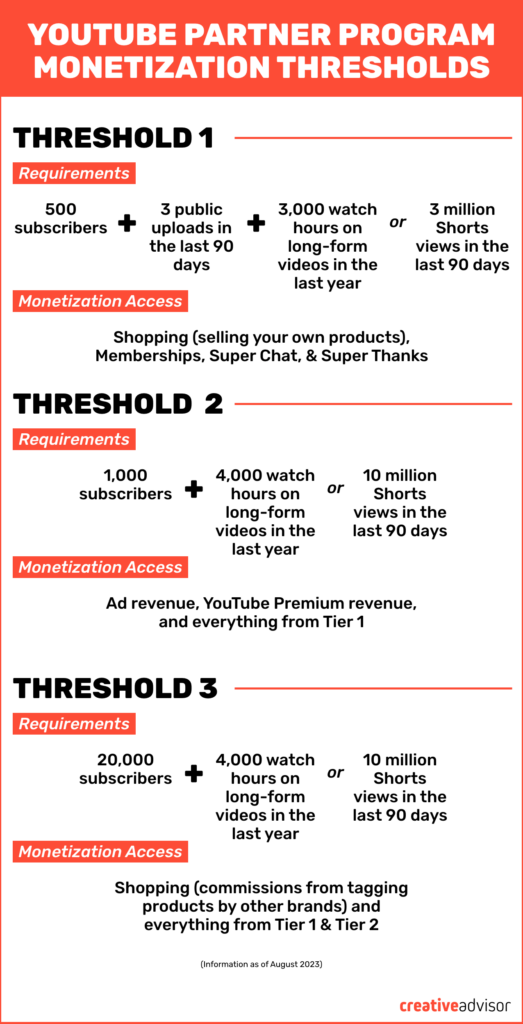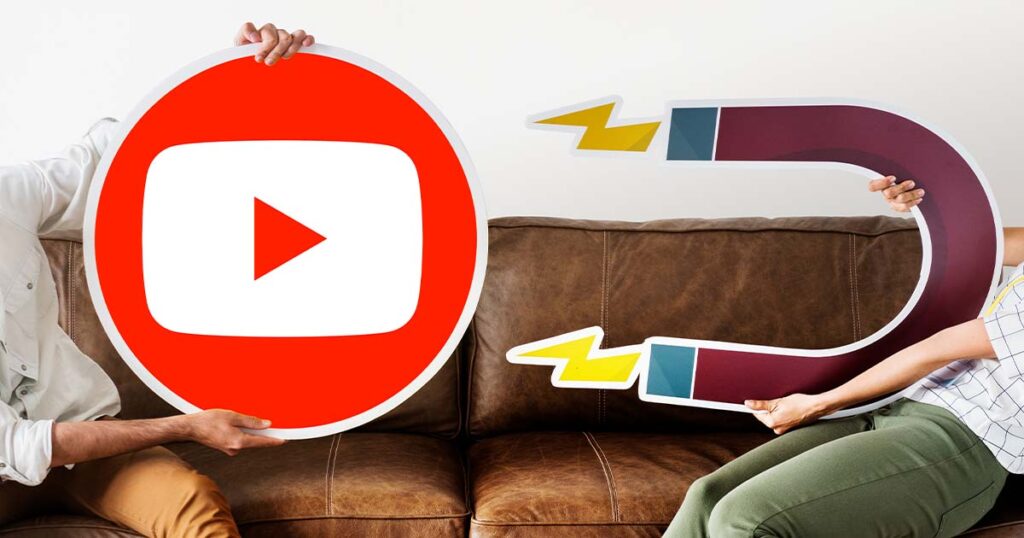YouTube isn’t just a video platform—it’s also a way to make money. With billions of hours of content viewed daily, it offers many opportunities for creators to turn their passion into profit. YouTube has transformed casual creators into millionaires and offered millions a livable income.
Leading YouTubers like Mr. Beast are reported to have made staggering amounts, tens of millions in Mr. Beast’s case, solidifying YouTube’s position as a lucrative career choice. While these numbers are impressive, it’s crucial to note that there isn’t just one route to YouTube wealth. The average YouTuber makes $65,999 a year, according to ZipRecruiter. Whether you’re striving to become the next big YouTube sensation or just looking to make a solid income, there are several monetization methods available to help you make a living while doing what you love.
In this guide we’ll go over the seven ways to make money as a YouTuber, how much money the average YouTuber makes, how long it takes to start making money on YouTube, and other platforms that offer monetization for video creators.
7 Ways to Make Money as a YouTuber
The opportunities to earn money on YouTube are numerous. Whether you’re a seasoned content creator or an aspiring YouTuber, implementing these monetization strategies can set the stage for consistent revenue. Here are the seven best ways to make money on YouTube:
- Join the YouTube Partner Program (YPP)
- Sign up for Affiliate Marketing
- Create Sponsored Content
- Sell Your Own Merch
- Build Subscription Memberships
- Offer Paid Promotions and Shoutouts
- Make Online Courses
1. Join The YouTube Partner Program (YPP)
Applying for the YouTube Partner Program (YPP) is the first step towards monetizing your channel.
The YPP allows creators who meet varying eligibility requirements to earn revenue from ads, shopping, and other fan funding features. In June 2023, YouTube lowered the eligibility threshold for the program by allowing creators with fewer subscribers and viewers to access some of these monetization tools. The YPP is now more accessible for aspiring YouTubers.
The Three Thresholds Of YPP Eligibility

YPP THRESHOLD 1
Requirements: 500 subscribers, three public uploads in the last 90 days, and either 3,000 public watch hours on long-form videos in the last year or 3 million public Shorts views in the last 90 days.
Features:
- Shopping (selling your products): Think of this as QVC for the digital age. By integrating products into videos, creators allow fans to purchase their products/merch directly, enhancing the shopping experience.
- Channel Memberships: This is like a VIP club for your biggest fans. For a fee, subscribers get exclusive badges, emojis, and sneak peeks, adding a layer of exclusivity.
- Super Chat & Super Stickers: Fans can buy prominence during live chats. Their comments get pinned, offering creators a revenue boost.
- Super Thanks: Gratitude monetized. Viewers can now tip creators, showing appreciation for their content through dollars.
*YouTube started rolling out access to this tier in 2023 in Canada, South Korea, Taiwan, the United Kingdom, and the United States.
YPP THRESHOLD 2
Requirements: 1,000 subscribers and either 4,000 watch hours over the last year or 10 million public Shorts views in the last 90 days.
Features:
- YouTube Ad Revenue Sharing: 55% of net revenue from ads displayed on your videos and 45% of net ad revenue from ads shown on your Shorts
- YouTube Premium Revenue: As YouTube Premium users watch videos ad-free, creators earn a share of their subscription fee, calculated based on how often they watch your content.
- Everything from Threshold 1
YPP THRESHOLD 3
Requirements: 20,000 subscribers and either 4,000 public watch hours on long-form videos in the last year or 10 million public Shorts views in the last 90 days.
Features:
- Shopping (products from other brands): This program enables creators to earn commissions by tagging retail products in their videos, streamlining viewer shopping experiences, and increasing overall earnings, all managed efficiently through YouTube Studio. To be eligible, you must have 20,000 subscribers and either 4,000 public watch hours on long-form videos in the last year or 10 million public Shorts views in the last 90 days.
- Everything from Thresholds 1 and 2
Related: How to Get More Views on YouTube
2. Sign Up For Affiliate Marketing
Affiliate marketing is a powerful tool in a content creator’s arsenal. It involves promoting third-party products or services and earning a commission for every sale made through your unique referral link. Every time your audience buys something you recommend, you get a cut of the profit.
Creators can insert their affiliate links in video descriptions or embed links in their videos, encouraging their audience to check out recommended products. Creators can also organically integrate product recommendations within the video content—like reviewing a product or showcasing its benefits. This is an excellent way for creators to make their promotions feel less intrusive and more genuine.
Choosing the right affiliate partners
It’s crucial for YouTubers to align with products and services relevant to their content and audience. Picking the right affiliate partners ensures authenticity, which is vital for trust. To get started, creators typically need to sign up for these programs, get their referral links, and then strategically incorporate them into their YouTube content.
Here are some of the most popular affiliate programs for YouTubers:
- Amazon Associates
- ClickBank
- eBay Partner Program
- Etsy Affiliate Program
- Shopify Affiliate Program
- ShareASale
- Sellfy Affiliate Program
- TripAdvisor
3. Create Sponsored Content
At the intersection of creativity and commerce lies sponsored content. This form of monetization involves brands paying YouTubers directly for showcasing or mentioning their products or services. Unlike traditional advertisements, these collaborations are weaved seamlessly into a creator’s video, making it feel organic and authentic. This can be very profitable.
When it comes to creating effective sponsored content, it’s not just about having a vast audience; it’s about having the right audience. Brands are keen to partner with channels that cater to their target demographic. So, while having a significant number of subscribers can be an advantage, an audience’s engagement level and relevance can sometimes matter more. For example, a niche tech channel with 20,000 engaged subscribers might be more valuable to a tech brand than a general entertainment channel with 100,000 passive subscribers.
The key to successful sponsored content is authenticity. YouTubers must strike a balance between promoting the brand and providing genuine value to their audience. It’s also crucial to be transparent about sponsorships by including disclaimers or verbal mentions. This builds trust with your viewers and ensures that creators adhere to platform guidelines and regulations.
4. Sell Your Own Merch

YouTubers, over time, develop a unique personal brand identity that resonates with their audience. Selling merchandise that aligns with that brand is a smart way to earn more income from your content. But it’s not just about generating revenue; it’s about strengthening the bond with the community.
Merchandise offers dual benefits: a direct revenue stream and free promotion. When fans wear your branded gear or use products with your logo, they’re essentially becoming walking advertisements. However, the merchandise must resonate with the channel’s niche and vibe to succeed. A tech reviewer might sell branded tech gadgets, while a fitness YouTuber could sell workout gear. The key is relevance to the content you’re creating.
Getting started selling merch
If you don’t qualify for YouTube’s Partner Program and can’t sell merch directly to your fans, there are third-party platforms you can use. Many platforms cater specifically to creators looking to sell merchandise. Teespring, for example, integrates directly with YouTube, allowing seamless promotion and sale of products.
Another route is collaborating with local businesses to produce custom merchandise, offering quality control and a personal touch. Regardless of the approach, the emphasis should always be on quality, ensuring fans get value for their money.
5. Build Subscription Memberships
With the unpredictable nature of ad revenue, creators are constantly seeking more stable and predictable income sources. Subscription-based models, where fans pay a monthly fee for exclusive content, perks, and community are gaining traction. This model enables creators to focus on creating without starting from zero every month.
Numerous platforms cater to this model. Patreon is the most popular, offering creators a platform to provide tiered subscription services. Ko-Fi and Buy Me A Coffee are simpler platforms serving similar needs. Discord, while primarily a communication platform, has been adopted by creators to build tight-knit communities where exclusive content, chats, and Q&A sessions are held for paying members. These platforms not only offer monetary benefits but also foster closer relationships with fans.
Success in the subscription model hinges on exclusivity and value. Creators must offer content or other benefits compelling enough to justify the subscription. This could be early access to videos, group chats, behind-the-scenes content, or even physical goods. Regular engagement is also critical; fans who feel neglected are unlikely to continue their subscription.
6. Offer Paid Promotions And Shoutouts
As channels grow, they don’t just attract fans—they attract other creators looking for a boost. These potential partners can be new YouTubers seeking exposure or established ones aiming for cross-promotion. By offering shoutouts or promotions, YouTubers can monetize this demand.
It’s not just about mentioning another channel; it’s about presenting it in a way that aligns with your content. For example, if you run a cooking channel and you want to promote an up-and-coming chef’s channel, you might collaborate on a recipe. The collaboration should feel organic to the audience, not forced.
While this can be a lucrative avenue, creators must be cautious. Promoting a channel that doesn’t resonate with your audience or compromises your brand can lead to a loss of trust. It’s essential to vet any channel you’re thinking of promoting, ensuring alignment in values and content quality.
7. Make Online Courses
Success on YouTube often comes with a wealth of knowledge about content creation, audience engagement, and branding. Many of your viewers will aspire to emulate your success. By packaging these learnings into online courses, YouTubers can offer tangible value to aspiring creators. By pursuing courses, you are monetizing every part of your creative process.
The course you create should be structured methodically, progressing from basics to advanced topics. Starting with content planning, scripting, and shooting then moving to advanced topics like analytics, growth strategies, brand partnerships, and business development ensures you are delivering comprehensive value to your viewers. Using a mix of video lectures, written content, and assignments can cater to different learning styles.
Udemy, Teachable, and Skillshare are popular choices for course hosting. They offer a mix of monetization options, from one-time purchases to subscription models. Promoting your course on your YouTube channel can drive enrollments, tapping into an audience already invested in your content and creator journey.
How Much Money Does The Average YouTuber Make?
It’s a common misconception that YouTube stardom equates to guaranteed wealth. The reality is that earnings on YouTube vary significantly based on factors like audience location, engagement rate, niche content, and more. According to 2023 data from InfluencerMarketingHub, YouTubers make an average of $0.018 per ad view. So, channels can earn anywhere from $3 to $5 per 1,000 video views or $18 per 1,000 ad views, but this can vary.
While top creators rake in millions annually, a large portion of YouTubers might only earn a modest income from the platform. Channels with a million subscribers might earn anywhere between $60,000 and $900,000 a year, but these are rough estimates.
The substantial earnings YouTubers bring in usually include a combination of ad revenue, sponsorships, merchandise, and other income streams. Meaning, in order to achieve YouTube riches, it’s important to utilize multiple monetization methods – like the ones listed in this article.
Given the unpredictable nature of earnings on YouTube, it’s essential to approach it with the right mindset. For some, it becomes a lucrative full-time job; for others, it remains a side hustle or passion project. Success often requires a blend of quality content, consistent uploads, and strategic monetization efforts beyond simply relying on ad revenue.
How Long Does It Take To Start Making Money on YouTube?
Starting a YouTube channel and expecting immediate revenue is not realistic. Earning potential is influenced by niche selection, video quality, audience engagement, and post consistency. For example, a channel in a popular niche like movie reviews might grow quicker than one focused on a niche hobby.
Before making any money from ads directly on YouTube, creators must join the YouTube Partner Program (YPP). Depending on the content and promotional efforts, this can take anywhere from a few months to over a year. But, of course, there are other methods, like the ones we’ve discussed here, that YouTubers can execute on that don’t require approval.
Monetization is not just about reaching the YPP threshold. It’s about building a loyal audience that engages with your content regularly. This means consistent uploads, engaging with comments, and staying updated with platform changes and trends. Prioritize building community and the sky’s the limit.
More Platforms That Offer Monetization Programs
- Twitch: Primarily a platform for gamers, Twitch offers several monetization options, including ads, subscriptions, and donations.
- TikTok: The TikTok Creator Fund allows creators to earn based on video performance.
- Instagram: Instagram has introduced creator subscriptions so followers can directly support their favorite creators.
Bottom Line
YouTube’s expansive user base and diverse content make it a promising platform for monetization. However, success doesn’t come overnight. It’s a culmination of understanding your audience, producing quality content, and leveraging multiple revenue streams. As the digital space continues to evolve, opportunities for content creators are bound to expand, but the core principle remains: offer value and stay committed.
Frequently Asked Questions
- How often should I post on YouTube? While there’s no one-size-fits-all answer, consistency is vital. Whether it’s once a week or daily, choose a schedule that’s sustainable for you and stick to it.
- Do I need expensive equipment to start a YouTube channel? No, many successful YouTubers started with just their smartphones. The key is content quality, not production value.
- How can I increase my video views? Engage with your audience, collaborate with other creators, promote your videos on other platforms, and make sure your titles, descriptions, and tags are SEO-friendly.




